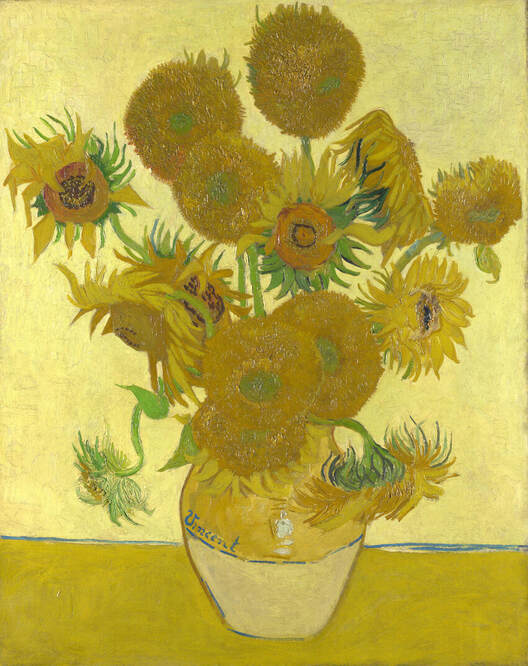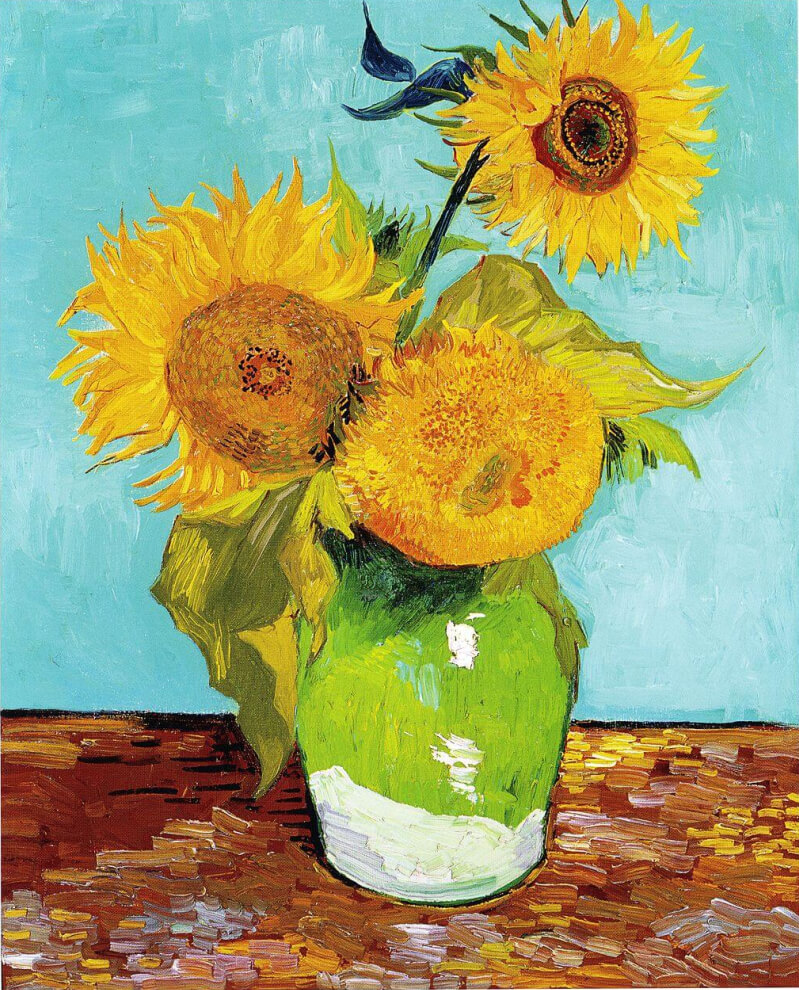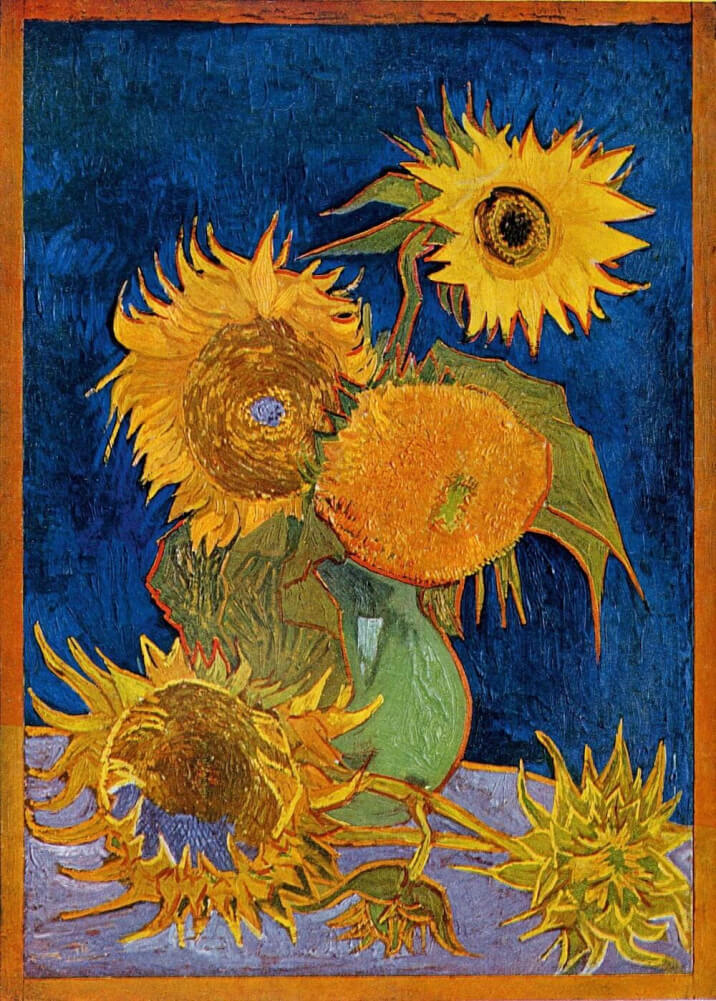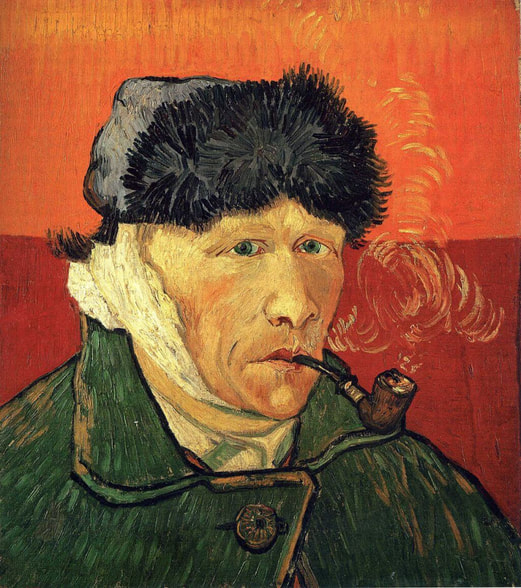|
Where? Room 43 of the National Gallery
When? 1888 What do you see? A total of 15 sunflowers is depicted. The sunflowers are actually dying, and you can see that almost half of the sunflowers does not have any petals left. Specifically, six sunflowers only have their flower head left, and the sunflower on the top right only has a single petal on it. This is an indication that they are at the end of their life. The sunflowers that we often adore are the ones with the petals still on it, and in combination with the flower head, they make the sunflower look like a sun with rays. The petals of the sunflowers that still have them are quite spiky. Notice also the colors that Van Gogh used. Besides some green, he used different shades of yellow. It is very difficult to create a painting with a clear subject and interpretation with such a limited array of colors, yet Van Gogh succeeded in creating a painting of sunflowers that can be recognized from a large distance. This still-life painting beams of the wall and energizes people around the world, something that is very uncommon for still-lifes which are often considered to be somewhat dull. Backstory: A painting of sunflowers is immediately associated with Van Gogh. He created a total of 11 paintings of sunflowers. The first series of four paintings shows sunflowers lying on the ground and the second series of seven paintings shows sunflowers in a vase. This second series contains four originals which he created in a single week. Van Gogh also made three copies of the paintings in the second series. Two of these three copies are copied from the Sunflowers version in the National Gallery. One of these copies is currently in the Van Gogh Museum in Amsterdam, and the other copy is in the Seiji Togo Memorial Sompo Japan Museum of Art in Tokyo (this version was sold for almost $40 million in 1987, making it the most expensive painting ever sold at that time). Sunflowers for Paul Gauguin: Van Gogh’s idea was to create these sunflower paintings as a decoration for the room of Paul Gauguin who would join him in Arles to paint. He knew that Gauguin liked sunflowers as, in the year before, Gauguin had exchanged one of his paintings for two of the earlier sunflower paintings of Van Gogh. Van Gogh was very excited that Gauguin would visit him and was in a fantastic mood when he created his second series of sunflower paintings. When Gauguin arrived, he was indeed impressed by these paintings and even Van Gogh himself was quite happy with the results (which was uncommon for him). The interest of Van Gogh in flowers was probably stimulated by his nationality as flowers are a very big part of the culture in The Netherlands. In fact, The Netherlands is the biggest flower exporting country in the world.
Symbolism: These sunflowers also have a symbolic value (though it is not clear how important this symbolic value was to Van Gogh). Flowers are a symbol of life. They have a period in which they bloom beautifully and they are in their prime, but eventually, they die. The cycle of a flower’s life is often used as an analogy for human life and should remind us of our own mortality. However, inside the flower head are the seeds of new life. These seeds refer to the cycle of life on this planet.
Who is Van Gogh? Vincent van Gogh (1853-1890) was born in Zundert in The Netherlands. He only started his artistic career in 1881 and so all the works we know from him are made within one decade. For many of his later paintings, Van Gogh studied a landscape, the sky, or some flowers in front of him while working on the painting. He liked to be outside while painting. His favorite color, which you can see in many of his paintings, is yellow. He considered yellow to be the color of life (as the sun is also yellow). Van Gogh developed a unique style of painting, which is very recognizable. Especially in his later years, he applied thick layers of paint to the canvas and used heavy brushstrokes. His work appeals worldwide to many people that are otherwise not so interested in art. Fun fact: Van Gogh’s idea was to create a painting community in Arles, where he moved in February 1888, but nobody wanted to join him there initially because of his difficult personality. However, the brother of Vincent convinced Paul Gauguin to join him and Vincent was very excited about this. On October 23, 1888, Gauguin joined Van Gogh in Arles. But the collaboration did not turn out well and Gauguin left in December 1888. According to Gauguin, Van Gogh threatened him with a razor and Gauguin ran away. That same night Van Gogh mutilated his own ear with a razor blade, which caused severe bleeding. He applied a bandage to his ear and packaged his ear in a piece of paper, which he brought to a woman in the brothel nearby that he frequented. He painted a self-portrait with a bandaged ear and pipe which is currently in a private collection.
Written by Eelco Kappe
0 Comments
Leave a Reply. |
Categories
All
|
- Home
- Blog
-
Museums
- Alte Pinakothek
- Art Institute of Chicago
- Baltimore Museum of Art
- Barber Institute of Fine Arts
- Bargello
- Barnes Foundation
- British Museum
- Church of Sant’Anastasia
- Cleveland Museum of Art
- Courtauld Institute of Art
- Detroit Institute of Arts
- Frans Hals Museum
- Galleria Borghese
- Gallerie dell'Accademia
- Getty Museum
- Guggenheim
- Hermitage Museum
- Kunsthistorisches Museum
- Kunstmuseum Basel
- Legion of Honor Museum
- Louvre
- Mauritshuis
- Metropolitan Museum of Art
- Musee d’Orsay
- Museum of Fine Arts in Boston
- Museum of Modern Art
- National Gallery in London
- National Gallery of Art
- National Museum in Poznań
- Norton Simon Museum
- Ny Carlsberg Glyptotek
- Palace of Versailles
- Palazzo Pitti
- Palazzo Vecchio
- Petit Palais
- Philadelphia Museum of Art
- Prado
- Pushkin Museum
- Ravenna Art Museum
- Rijksmuseum
- San Diego Museum of Art
- Santa Maria delle Grazie
- St. Peter's Basilica
- Städel Museum
- Statens Museum for Kunst
- Tate Britain
- Tate Modern
- Timken Museum of Art
- Uffizi
- Vatican Museums
- Wallace Collection
-
Artists
- Altdorfer
- Anguissola
- Berlin Painter
- Bosch
- Botticelli
- Boucher
- Bronzino
- Bruegel the Elder
- Brunelleschi
- Cabanel
- Caillebotte
- Canova
- Caravaggio
- Carpeaux
- Cezanne
- Cimabue
- David
- Degas
- Delacroix
- De Maria
- Donatello
- El Greco
- Fontana
- Fra Angelico
- Fragonard
- Gauguin
- Gentileschi
- Gericault
- Gonzalez-Torres
- Goya
- Hals
- Hogarth
- Hokusai
- Ingres
- Leonardo da Vinci
- Lippi, Filippo
- Longhi, Barbara
- Lorrain
- Makovsky
- Manet
- Massys
- Matisse
- Merian
- Michelangelo
- Mochi
- Modigliani
- Monet
- Panini
- Parmigianino
- Perugino
- Picasso
- Pisanello
- Raphael
- Rembrandt
- Renoir
- Reynolds
- Rivera
- Rodin
- Rubens
- Scultori
- Seurat
- Steen
- Tintoretto
- Titian
- Toulouse-Lautrec
- Turner
- Uccello
- Van der Weyden
- Van Dyck
- Van Eyck
- Van Gogh
- Van Hemessen
- Vasari
- Velazquez
- Vermeer
- Veronese
- Vigée Le Brun
-
Locations
- Books
- About Us





